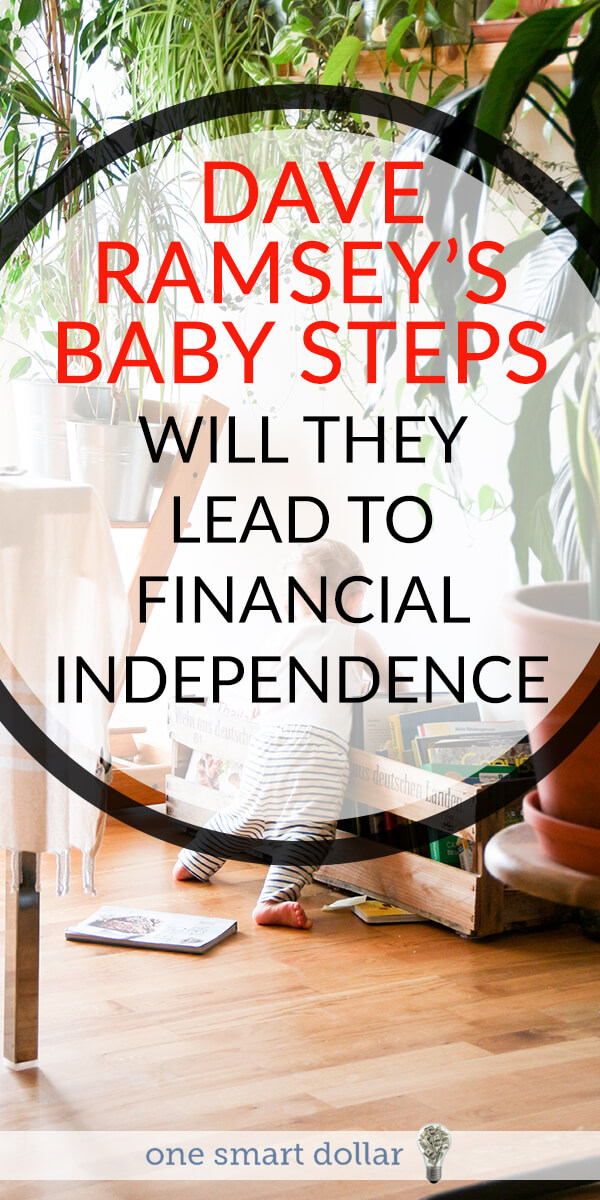
Dave Ramsey is one of the most famous financial advisors in the country. He has a popular radio show turned podcast, a series of books, and even a curriculum called Financial Peace University that is taught in hundreds of location nationwide.
He teaches people how to become debt-free using a set of basic principles called Dave Ramsey’s Baby Steps. Dave Ramsey’s Baby Steps have become famous because of the people who have followed them to achieve their financial goals.
So I’m sure you’re wondering, are Dave Ramsey’s Baby Steps really all they’re cracked up to be? Let’s dig a little deeper and find out.
What are Dave Ramsey’s Baby Steps?
There are 7 Baby Steps that, when followed in order, Dave Ramsey guarantees will help anyone achieve financial freedom.
1. Save $1,000 to start an emergency fund
The logic behind this step is pretty straightforward. Before you can reach financial success, you need to establish stability. The reason why so many people get trapped in a cycle of debt is that of unexpected expenses.
In order to become debt-free, you need to have a safety net. That’s why the first Baby Step is to create an emergency fund. That is the cushion you’ll need to overcome unexpected expenses and stay on track to achieving your financial goals.
Side note: If you are looking for a good place to set up or move your emergency fund, take a look at CIT Bank. They have some of the highest rates available on both high yield savings accounts and money market accounts.
2. Pay off all your debts (except your home) using the debt snowball method
Dave Ramsey’s favorite way to tackle your debt is called the snowball method. On this Baby Step, you’ll pay off each of your debts one by one.
Start by focusing on your smallest debt, whatever that may be. Funnel all your extra money toward that debt and continue making the minimum payments on all your other debts. Once you’ve paid off the first debt, you’ll move on to the next biggest debt and repeat until each is paid in full.
The idea is that each time you eliminate one of your debts, you direct that same payment amount to your next debt. Just like a snowball gets bigger as it rolls downhill, the payment you can make toward your debt gets larger as you tackle each subsequent debt.
3. Save 3-6 months of expenses in your emergency fund
By the time you’ve reached this step, you’ll be debt free! Using the money that you were previously putting toward debt, you can now focus on amplifying your safety net.
The most important part of this stage is not to be tempted to go out and splurge. Just because you’re debt-free doesn’t mean you’re a millionaire! Building wealth takes time and a strong foundation, which includes having a solid three to six months of expenses saved up.
4. Invest 15% of your household income into Roth IRAs and pre-tax retirement funds (like a 401k)
This step is where you funnel your income into your big picture financial goals. With a strong safety net and no debt, saving 15% of your income won’t even feel like a stretch. The sooner you get to this step, the sooner your investments will start to grow. Money plus time equals wealth, so this is the step that takes you even closer to the financially secure lifestyle you’ve dreamed of.
Side note: If you already have a 401k set up through your employer, make sure you check out Blooom. They will give you a free analysis of your 401k, helping you uncover any unnecessary fees.
Additional Reading
- Which IRA Is Better: Traditional or Roth IRA
- How Much Should I Have In My 401k?
- How To Set Up a 401k
- What Does Retirement Mean To You?
5. Save for your children’s college fund
There are no hard-and-fast rules for this step. If you reach this step before you have kids, then you’re well on your way. But if you’re past the point of having kids, or decided that kids just aren’t for you, don’t get too caught up here.
The point of this step is to ensure that you don’t have to dip into your retirement funds if you decide now or later that you’d like to help fund your children’s education. Many families pull money out of their retirement savings and end up having to work years or even decades longer than expected to make up the difference.
Also Read: What is a 529 College Savings Plan?
6. Pay off your home early
Most of the time, Dave Ramsey’s Baby Steps four, five, and six are done simultaneously. With no other debt besides your mortgage, you should be able to funnel funds toward all three goals.
Paying off your mortgage early is one of the best ways to save money. Over the course of a 30-year mortgage, most people end up paying for their house nearly twice over simply because of the amount of interest.
A paid-off home eliminates your very last source of debt and gives you the power to leverage that home to build more wealth through additional real estate investments if you so choose.
7. Build wealth and give/donate
It can take years or even decades, but those who stick to the plan nearly always make it to the final Baby Step! This is when you get to live like no one else because of all the sacrifices you’ve made.
At this stage, you can use the cash you’ve saved to fund your dreams. It might be a vacation, a new car, or starting your own business — once you get here, your opportunities are endless because you’ve worked hard to establish complete financial stability.
What’s so special about Dave Ramsey’s Baby Steps?
At first glance, the Baby Steps look pretty simple. So what’s the catch? In theory, the Baby Steps can help anyone build momentum through small wins along the way, and it’s that momentum that keeps people on the right path when it comes to their finances.
Plus, it keeps you focused on achieving more than just a debt-free life; Dave Ramsey’s baby steps guide you on a long-term path that includes saving for retirement and for your family’s future.
Why isn’t the first Baby Step paying off debt?
If you’re like me, you’re probably surprised that the first step is to save money — rather than paying off debt. However, it makes sense when you think about it. How many times have you tried to pay off your credit card or student loan, but you couldn’t because some other expense came up?
$1,000 doesn’t sound like that much, but it’s more than enough to cover the cost of any unexpected car repair or medical appointment. It will help cover an event that could otherwise derail your success.
Do the Baby Steps work?
If you’re someone who has struggled with your finances and especially with issues like credit card debt and loan repayment, the baby steps are exactly what you’re looking for.
By focusing on building an emergency fund and paying off your debts, you’ll learn how to stop using debt as a crutch. By forcing you to focus on just one goal at a time, Dave Ramsey will help you get ahead of your financial issues and start gaining traction once and for all.
Should I try Dave Ramsey’s Baby Steps?
Absolutely! But keep in mind that like any strategy, Dave Ramsey’s Baby Steps are just an outline, not a hard-and-fast rulebook for every single situation. Dave Ramsey’s advice is to stick to the Baby Steps at all costs.
But there are a lot of people out there who have achieved financial freedom by tweaking the steps for their own unique situations. Here are a few ideas that might help the Baby Steps work better for you:
- If you have an employer match for your retirement account, start investing that amount. Over time, that money you invest will build thanks to compound interest, potentially earning you more in the long run than if you had used it to pay off debt.
- Pay off your debts using the debt avalanche method instead of the debt snowball method. The avalanche may save you money by focusing your extra payments on your high-interest debts. Beware though that the snowball method is the tried-and-true favorite because of how motivating it feels to pay off your debts.
- If you’re risk-averse or don’t have a stable source of income, start with a higher number for your initial emergency fund before you start directing your extra money toward debt.
- While working on your emergency fund, refinance your debts so that you’ll have a lower interest rate in the meantime. Take a look at Credible.com because they have rates as low as 4.99%.
- Save more than 15% for your retirement by diversifying across your Roth IRA, 401(k), and other tax-advantaged accounts you might be eligible for like HSAs.
- Adjust your retirement savings to 20%-30% depending on how close you are to retirement, or if you have a goal of retiring early.
- Step #5 doesn’t have to be just about your kids. You can modify it for your own goals. But if you do that, make sure you swap steps five and six so that you can pay off your mortgage early. Then, use what used to be step five to save for a second home, your dream vacation, your own business, or another big milestone.
Want to learn more about Dave Ramsey’s methods of becoming financially independent? Check out these books…
- The Total Money Makeover: Classic Edition
- Dave Ramsey’s Complete Guide to Money
- The Financial Peace Planner
- Financial Peace Revisited

